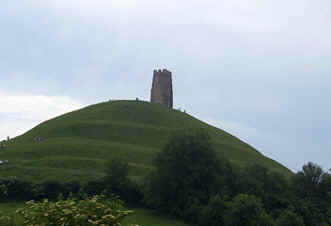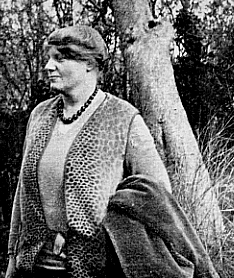|
|
In the Golden Dawn Tradition - Dion Fortune Part 1 | Part 2 Ritual Magic & the Golden Dawn
Present at similar occult ritual work at Glastonbury, Somerset, was architect and antiquary Frederick Bligh Bond. In 1907 Bond had been employed to excavate the ruins of Glastonbury Abbey and had secretly recruited a medium called John Allen Bartlett to help show him where to dig. Guided by automatic writing they assembled plans which led to the discovery of both the St. Mary's Chapel and the Edgar Chapel. However, when Bond revealed the means he had used, in his 1918 book The Gate of Remembrance, he was banned from any further connection with the by now Church of England-owned abbey. One magical moonlit night in 1922, at Chalice Well, Glastonbury, Dion Fortune met Charles Thomas Loveday, an executive in London Tramways. Though he was around sixteen years her senior, there was an instant bond between them and their lives became closely connected in occult ritual work from then on. That they first met at Glastonbury is only natural, this ancient and holy place had always been somewhere with which Dion Fortune had a deep spiritual connection. In 1924 her own esoteric group erected an old army officers' hut at the foot of Glastonbury Tor, naming the site Chalice Orchard. This became the first headquarters of 'The Fraternity of the Inner Light' (later re-named the Society of the Inner Light). 1927 was a mixed year for Dion Fortune. On 6 April that year, she married Dr. Thomas Penry Evans at Paddington Register Office. During the same period she was having trouble within the Alpha et Omega Order, with its chief adept Moina Mathers, a gifted occultist, psychic, and ritual magician and wife of MacGregor Mathers, one of the founders of the Golden Dawn. Part of the problem stemmed from Fortune's establishment of her own ritual group within the Alpha et Omega, Moina Mathers realising that this posed a serious threat to the Order itself. Further problems arose with the publication of Fortune's occult short stories (The Secrets of Dr. Taverner) and, more importantly, a series of articles for the Occult Review (which were later published as Sane Occultism) which Moina Mathers, who believed strongly in the necessity for secrecy, felt were betraying the secrets of the Order. However, it was pointed out that a junior initiate in what was by now Moina's magical Order would not have advanced to a sufficiently high grade to access such 'secrets'. Mathers subsequently expelled Fortune because the correct symbols had not appeared in her aura, 'a perfectly unanswerable charge' as Dion fortune said later. In July the following year Moina Mathers was dead, aged 63. The Society of the Inner Light At the Winter Solstice of 1928, the 'Lesser Mysteries of the Fraternity of the Inner Light' were created, hence the Fraternity was ritually established. 1927 was also the year that Dion Fortune had her first 'occult' novel published The Demon Lover. In 1928 the first of her non-fiction occult textbooks appeared The Esoteric Orders and their Work and shortly afterwards The Training and Work of an Initiate. In 1930 perhaps her best known work, Psychic Self-Defence was published. One particularly remarkable incident detailed in Psychic Self-Defence shows that, like French mystic and traveller Alexandra David-Neel (see article on this site) Dion Fortune had the ability to create visible thought forms that could exist independently of their creator. At the time she had been thinking deeply about someone who had upset her, and 'formulated a werewolf accidentally'. She was lying in bed imagining Fenrir, the mythical Norse wolf-monster, when she sensed the presence of a large grey wolf. Although she 'knew nothing of the art of making elementals at that time' she had inadvertently found the correct method for summoning them. Nudging the wolf she told it, 'If you can't behave yourself, you will have to go on the floor.' The beast then vanished through the wall. It later transpired that another member of the household claimed to have seen the wolf's eyes in the corner of her own room, though how much suggestion played a part in this 'sighting', and how subjective Fortune's experience was it is difficult to say. Fortune called the animal back to her, at the same time noticing a thin cord connecting it to her. Visualizing herself drawing the essence from the wolf along the cord, she apparently managed to dissolve it. Dion Fortune's Occult Writings
However, this book forms the basis of her occult work, which she once explained as 'the revival of the ancient Temple Mysteries'. In her wide-ranging and often outstanding occult novels, such as The Goat-Foot God (1936), The Winged Bull (1936), and The Sea Priestess, (1938), we again have the practical details of sometimes secret esoteric rituals and knowledge, presented in the form of fiction, her attempt to transmit esoteric and occult principles to as wide a public as possible. The Magical Lodge at Queensborough Terrace By
the early 1930s the Society of the Inner Light had acquired a house in
Queensborough Terrace, Bayswater, London, which was not
only an established
magical lodge but also provided accommodation for some members, including Dion Fortune and her husband
Dr. Penry Evans. Chalice Orchard was now established as a sanctuary for meditation. The
Society
was by now a high level initiatory school and provided fascinating and varied lectures
on the occult, many by Dion Fortune herself. During
the Second World War the Society was bombed out of Queensborough
Terrace, but as there was no serious structural damage they were able to move
back in after a few weeks. At the end of 1945 Dion Fortune fell ill and, in early January 1946,
was admitted to Dion Fortune's pioneering influence is much in evidence amongst
new age people,
contemporary occultists, Wiccans, Pagans and Ritual Magicians. This influence is felt not only
through the teachings of The Society of the Inner Light and various related
organisations but also in her novels
and occult text books, many of which are still popular today. The
combination of profound esoteric knowledge and concepts of Jungian psychology,
with a clear no-nonsense approach to occult writing and teaching have produced perhaps
the most accessible and naturally talented occultist of the 20th century. Sources and Further Reading Cavendish, Richard. Encyclopedia of the Unexplained. London, Routledge and Kegan Paul, 1974. p88. Chapman, Janine. Quest for Dion Fortune. Maine, Samuel Weiser, Inc. 1993. Fielding, Charles, & Collins, Carr. The Story of Dion Fortune. Loughborough, Thoth Publications. 1998. Fortune, Dion. Psychic Self-Defence. London, S.I.L. (Trading) Ltd., 1997 (1930). Fortune, Dion. The Mystical Qabalah. London, Ernest Benn Ltd., 1979 (1935). Greer, Mary K. Women of the Golden Dawn. Rochester, Park Street Press. 1995. Knight, Gareth. Dion Fortune and the Inner Light. Loughborough, Thoth Publications. 2000. Richardson, Alan. Priestess. The Life and Magic of Dion Fortune. Wellingborough, Northamptonshire, The Aquarian Press. 1987.
|
|
[ My Books | Articles | Mailing List | Advertise ] |
|
[ Strange Powers & Abilities | Psychics | Feral Children | Poltergeist Stories | Weird People | Occult People ] |

 It was now that Violet Firth adopted the motto Deo Non
Fortuna (also the Firth family motto) - God not luck - as
her magical name of Dion Fortune. However she soon grew disillusioned with the Golden
Dawn and its magical practices,
finding that it consisted mainly of widows and 'squabbling greybeards'.
Though within the Order she found help and support
from an old family friend Maiya Curtis-Webb, who was present during Dion
Fortune's early experiments in trance mediumship, an ability she maintained
until she died.
It was now that Violet Firth adopted the motto Deo Non
Fortuna (also the Firth family motto) - God not luck - as
her magical name of Dion Fortune. However she soon grew disillusioned with the Golden
Dawn and its magical practices,
finding that it consisted mainly of widows and 'squabbling greybeards'.
Though within the Order she found help and support
from an old family friend Maiya Curtis-Webb, who was present during Dion
Fortune's early experiments in trance mediumship, an ability she maintained
until she died.  In
her book The Mystical Qabalah, published in 1936 and still widely
studied by occultists today, Dion Fortune pioneered the use of the Qabalah as a key to the Western Mystery
Tradition. In this and most of her other occult non-fiction she presents and explains often extraordinary
esoteric and ritual material in a realistic and down-to-earth way making the material
accessible even to the untrained. Less
easy to follow, mainly because it
was written for initiates, is 'The
Cosmic Doctrine'. This was received mediumistically and intended for meditation rather than as a straight-forward
magical textbook.
In
her book The Mystical Qabalah, published in 1936 and still widely
studied by occultists today, Dion Fortune pioneered the use of the Qabalah as a key to the Western Mystery
Tradition. In this and most of her other occult non-fiction she presents and explains often extraordinary
esoteric and ritual material in a realistic and down-to-earth way making the material
accessible even to the untrained. Less
easy to follow, mainly because it
was written for initiates, is 'The
Cosmic Doctrine'. This was received mediumistically and intended for meditation rather than as a straight-forward
magical textbook. 